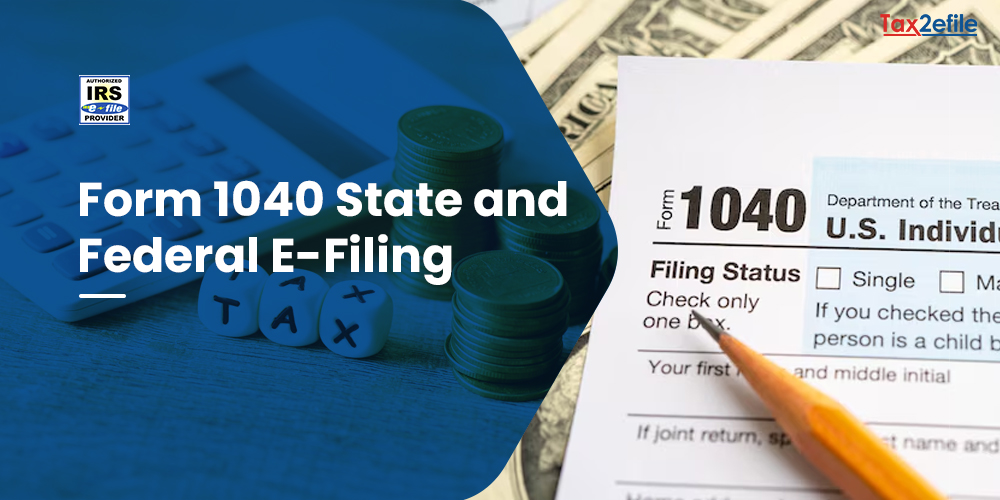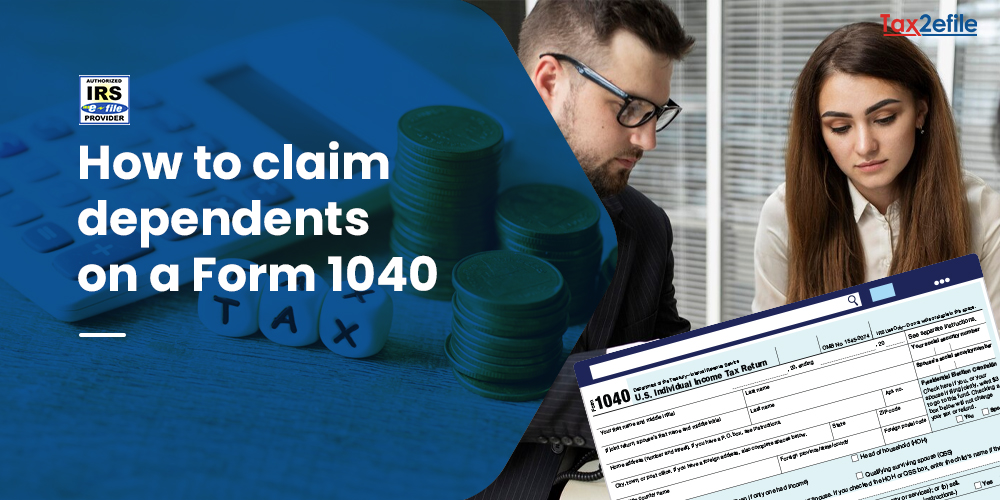- April 3, 2024

The IRS tax Form 1040 is a standard Form that helps individual taxpayers in the United States file their annual income tax returns. This Form enables taxpayers to disclose their taxable income for the tax year, determine whether they owe additional taxes to the IRS, and determine whether the taxpayer will receive a tax refund. While filing this IRS Form 1040, taxpayers should disclose their personal information such as name, address, SSN, and the number of dependents on the tax Form.
Who Should File Form 1040
The IRS tax Form 1040 needs to be filed by the IRS by 15th April. Everyone who is required to earn an income beyond a certain threshold should file their income with the IRS. There are three conditions that govern if the individual is required to file IRS Form 1040. The IRS demands individuals beyond a certain level of gross income to file their taxes. This threshold varies depending on the filing status of the individual. Older individuals will have a higher threshold. The gross income thresholds for the year 2023, to be filed in the year 2024, are as follows,
- For single taxpayers, the gross income should be above $13,850 to file the tax returns. For married individuals filing the tax form jointly, the threshold is $27,700.
- For head of household, the threshold is $20,800.
The income thresholds for the tax year 2024, to be reported in 2025, are as follows,
- To file tax returns, single taxpayers’ gross income should be above $14,600. For married individuals filing the tax form jointly, the threshold is $29,200.
- For head of household, the threshold is $21,900.
The gross income thresholds for the year 2024, to be filed in the year 2025, are as follows,
- To file tax returns, single taxpayers’ gross income should be above $14,600. For married individuals filing the tax form jointly, the threshold is $29,200.
- For head of household, the threshold is $21,900.
Who Need Not File Form 1040?
Children and dependents who claim to be dependents are not required to file Form 1040. However, if the dependent’s unearned income is greater than $1,250 and is under $12,500, the dependent should file IRS Form 1040 separately. Certain specific situations demand that the individual file Form 1040, irrespective of their income and dependency status. These special considerations are as follows.
State and Federal Filing Norms
The IRS Form 1040 is available on the IRS website. It is a two-page Form that taxpayers must fill out and mail to the IRS. The form can also be E-filed at the IRS website. In this tax Form, taxpayers are asked about their filing status and personal information such as their name, address, SSN, and the number of dependents.
The Income section of this tax Form asks the taxpayer to report their wages, salary, taxable interest, pensions, capital gains, social security benefits, and other forms of income. A number of deductions, such as tax preparation fees, employee expenses, and the cost of moving for a job, are eliminated under the new tax legislation.
The IRS Form 1040 follows a building block approach and allows the taxpayers to add only the schedules that the taxpayer required for their tax returns. Some individuals may file one or more of their six supplemental schedules, along with 1040 Forms, to report certain income.
Form 1040 Instructions Schedules
The IRS makes use of a number of additional schedules that help taxpayers to report their tax obligations. The following are the schedules that the taxpayers can use to compile their financial information
Schedule 1:
Schedule 1 is used to report additional income and adjustments that the taxpayer makes to their income. This might include alimony, disposition proceeds from the sale of a business, educator expenses, contributions towards health savings accounts, and unemployment compensation. The other income from Schedule 1 is generally reported on line 8 of the tax Form 1040. The adjustments that are made to the income in Schedule 1 will be reported on line 10 of Form 1040.
Schedule 2:
The taxpayers can use Schedule 2 to report the additional taxes. One part of Schedule 2 is used to report the alternative minimum tax and the repayment of the excess premium tax credits for insurance bought through the health insurance marketplaces.
The next part of Schedule 2 can be used to report self-employment taxes, Medicare taxes, and taxes on individual retirement accounts. It can also be used to report household employment taxes. The two parts of Schedule 2 should be reported on lines 17 and 23 of the IRS Form 1040, respectively.
Schedule 3:
Schedule 3 can be used to report the additional tax credits and payments. These credits will include the dependent care expense credits, residential energy credits, excess social security taxes remitted previously, and excess federal income taxes remitted previously. The non-refundable credits from Schedule 3 are reported on line 20 of the IRS Form 1040, while the refundable credits are reported on line 31 of the same Form.
Apart from these three schedules, there are also additional schedules that are associated with Form 1040.
Schedule A: Itemized Deductions
This is used to identify the taxpayer’s itemized deductions, which include medical and dental expenses, taxes, interest assessments, theft losses, and other expenses. The inputs from Schedule A are entered in Line 12a of Form 1040.
Schedule B: Interest and Ordinary Dividends
This is used for taxpayers receiving greater than $1500 of taxable interest or dividends. This is also used to report interest attained from a mortgage, interest from bonds, dividends as nominees, etc. The returns should be entered in line 2b and line 3b of the tax Form 1040.
Schedule C: Business Profits
This schedule is used to report the business income and loss. Profits from the business should be entered on Schedule 1, line 3, and also on Schedule SE.
Schedule D: Capital Gains and Losses
This schedule is used to report the taxable income from the sale or the exchange of a capital asset. This schedule is also used to report capital gain distributions that are not generally reported on Form 1040. The inputs of this schedule are entered on Form 1040, Line 7.
Schedule E: Supplemental Income and Loss
Schedule E of Form 1040 actively requires you to report additional income and losses from various sources. These sources include real estate rental income, partnerships, royalties, estates, and trusts.
Schedule EIC: Earned Income Credit
The EIC schedule is different from other tax schedules. It is calculated separately and used to substantiate the qualification of the qualifying children by remitting the name, SSN, birth year, and residency status of the child. The details of the other schedules that are part of IRS Form 1040 are as follows.
- Schedule F- reports profits and losses from farming operations
- Schedule H -used to report household employment taxes
- Schedule J – reports income from farming and fishing trade
- Schedule R – reports credits for the elderly and disabled
- Schedule SE – reports that tax due on the net earnings from self-employment
- Schedule 8812 – reports refundable credits for qualifying children.
Step-by-Step Guide to E-File 1040 Forms with Tax2efile
Taxpayers can easily submit their IRS Form 1040 to the IRS well ahead of the due date by choosing to e-file the tax Form. E-filing has a number of advantages. They can file the Form before the deadline and will also be able to file an error-free tax Form with the IRS. Choosing to e-file through Tax2efile has additional benefits as well. Their taxing experts will assist the taxpayer through the process and help with hassle-free tax filing.
E-filing IRS Form 1040 with Tax2efile is easy and fast and the individual can receive the IRS response for the filing within 24 to 48 hours. The portal offers premium service for its clients and their teams to handle the entire tax filing process on behalf of the individuals. Their prices are low and affordable and they also offer a number of discount coupons for their customers. They also have a dedicated cyber security team to protect the personal information of their clients at every step.
To start with Tax2efile the user has to register and login with the portal as the first step and choose the tax Form on which they require help. They then have to feed their tax details and submit the form to the IRS, after paying the taxes. They then have to wait for email confirmation from the IRS. Users can also use their service on the go, as their app is compatible with iPhone, iPad, and all Android devices.
Significance of IRS Form 1040 in U.S. Tax Filing
The IRS Form 1040 is the primary tax Form that the taxpayers of the U.S. use to file their annual income tax returns. The taxpayers will input their personal and tax information on the Form and submit it to the IRS for its review. This Form is the central part of the tax filing process for the citizens of the United States. It grasps all the financial statements of the individual and supports their tax schedules.


